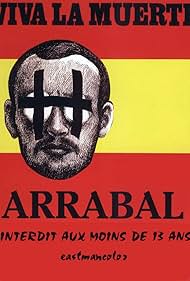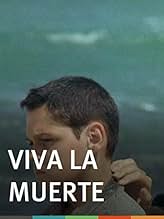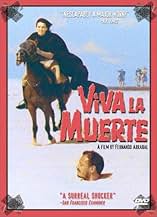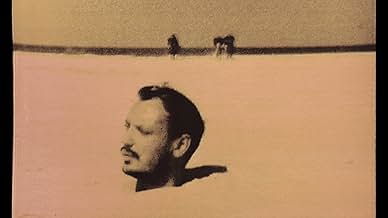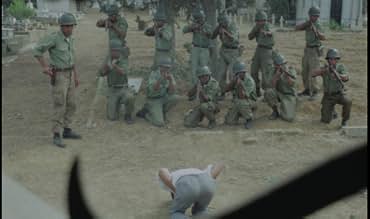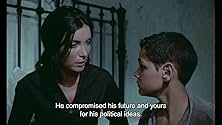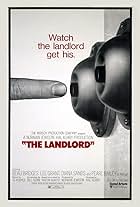VALUTAZIONE IMDb
6,5/10
1554
LA TUA VALUTAZIONE
Aggiungi una trama nella tua linguaDuring Spanish Civil War, young Fando navigates parents' clashing ideologies after father's arrest. Explores his imagination, friendships, views on sex and death amid family upheaval. Questi... Leggi tuttoDuring Spanish Civil War, young Fando navigates parents' clashing ideologies after father's arrest. Explores his imagination, friendships, views on sex and death amid family upheaval. Questions mother, seeks father's fate.During Spanish Civil War, young Fando navigates parents' clashing ideologies after father's arrest. Explores his imagination, friendships, views on sex and death amid family upheaval. Questions mother, seeks father's fate.
Trama
Lo sapevi?
- QuizIn 1981 Núria Espert recalled the infamous slaughterhouse scene: "It was shot in Viserta, a city in the north of Tunisia. They were going to kill some animals that day; we put a camera in front of them and filmed. Before filming, Arrabal told me what the scene meant and we started filming like a happening. A happening is something that only happens once, it is a theatrical representation that cannot be repeated, because it is based on emotions. "I took out the knife like an actress, I had in mind what Arrabal had spoken to me about and, on the other hand, there was the connection between Nuria the actress and Nuria the person. Then came the unpredictability brought by those thousands of litres of blood and shit. To the point that my body was totally and absolutely out of control. So much so that I felt that I had gone further than I have ever gone before. The musicians of the orchestra, fainted around me, as if we were going to die. Nobody died; we bathed and something else."
- BlooperWhen Fando is up at the lighthouse and urinates on the city, a hose behind his legs is clearly visible at times.
- ConnessioniFeatured in Jonas in the Desert (1994)
- Colonne sonoreEkkoleg
Written and Performed by Grethe Agatz
Recensione in evidenza
Viva La Muerte is the first instalment in a trilogy of surrealistic / political films by Fernando Arrabal. Based on a semi-autobiographical novel by Arrabal, Viva La Muerte follows ten-year-old Fando as he explores friendship, sexuality, betrayal and death in the midst of the Spanish civil war.
After Fando's father is arrested for treason, his mother tells him that he committed suicide in prison but Fando is suspicious and seeks to learn the truth. He soon discovers that his mother was responsible for his father's arrest and that he is alive and well.
When Fando is not making effigies for his disturbed little puppet theatre he is either sticking close to his mothers side, having gruesome hallucinations or hanging out with his little gal pal Therese, who is never without her pet turkey. The hallucination sequences are some of the best scenes in the film, they range from Arrabal's obsession with defiling religious iconography to Fando fantasising about flooding the town with his urine and his mother taking a dump on his incarcerated father's head. These scenes were shot on video then filtered through various abstract colour schemes which produces some very unsettling visuals.
La Muerte's opening credits sequence features some absolutely stunning and horrific Bosch-esquire illustrations by Roland Topor, co-founder of the Panic Movement along with Arrabal and Jodorowsky, accompanied by a sweet children's refrain that really sets the tone for what is about to come.
Fando's relationship with his mother and aunt both seem to have Oedipal / incestuous undertones, which are especially notable in the scene where his aunt forces him to flagellate her, during which she violently grabs & twists his scrotum. Although, scenes like this and another wherein a soldier shoots a "faggot" poet in the asshole seem like nothing compared to the closing sequence where a bull is graphically slaughtered and Fando's mother writhes ecstatically in the hot fountain of blood, smearing her face with it then she proceeds to sew an unknown man into the carcass of the bull. Later on the bull's cadaver is castrated and his testicle sac emptied onto the ground. If that isn't enough for all you PETA sympathisers there's also a bunch of lambs mercilessly butchered.
Undoubtedly the scenes of animal slaughter may turn a lot of viewers off, but they are not used in the way that a film like, say, Cannibal Holocaust uses them. There is also footage of open heart surgery, but in the hands of Arrabal all of these easily exploitable elements actually go toward the films credit and fit perfectly within the perverse, violent and fantastic world that is Viva La Muerte.
After Fando's father is arrested for treason, his mother tells him that he committed suicide in prison but Fando is suspicious and seeks to learn the truth. He soon discovers that his mother was responsible for his father's arrest and that he is alive and well.
When Fando is not making effigies for his disturbed little puppet theatre he is either sticking close to his mothers side, having gruesome hallucinations or hanging out with his little gal pal Therese, who is never without her pet turkey. The hallucination sequences are some of the best scenes in the film, they range from Arrabal's obsession with defiling religious iconography to Fando fantasising about flooding the town with his urine and his mother taking a dump on his incarcerated father's head. These scenes were shot on video then filtered through various abstract colour schemes which produces some very unsettling visuals.
La Muerte's opening credits sequence features some absolutely stunning and horrific Bosch-esquire illustrations by Roland Topor, co-founder of the Panic Movement along with Arrabal and Jodorowsky, accompanied by a sweet children's refrain that really sets the tone for what is about to come.
Fando's relationship with his mother and aunt both seem to have Oedipal / incestuous undertones, which are especially notable in the scene where his aunt forces him to flagellate her, during which she violently grabs & twists his scrotum. Although, scenes like this and another wherein a soldier shoots a "faggot" poet in the asshole seem like nothing compared to the closing sequence where a bull is graphically slaughtered and Fando's mother writhes ecstatically in the hot fountain of blood, smearing her face with it then she proceeds to sew an unknown man into the carcass of the bull. Later on the bull's cadaver is castrated and his testicle sac emptied onto the ground. If that isn't enough for all you PETA sympathisers there's also a bunch of lambs mercilessly butchered.
Undoubtedly the scenes of animal slaughter may turn a lot of viewers off, but they are not used in the way that a film like, say, Cannibal Holocaust uses them. There is also footage of open heart surgery, but in the hands of Arrabal all of these easily exploitable elements actually go toward the films credit and fit perfectly within the perverse, violent and fantastic world that is Viva La Muerte.
I più visti
Accedi per valutare e creare un elenco di titoli salvati per ottenere consigli personalizzati
- How long is Long Live Death?Powered by Alexa
Dettagli
Contribuisci a questa pagina
Suggerisci una modifica o aggiungi i contenuti mancanti

Divario superiore
By what name was Viva la muerte (1971) officially released in India in English?
Rispondi